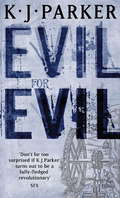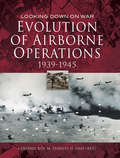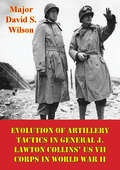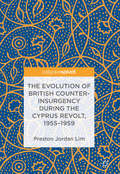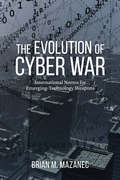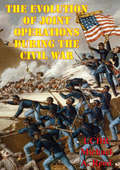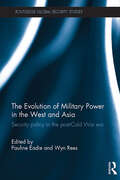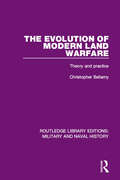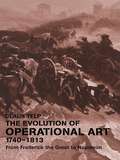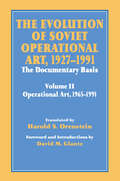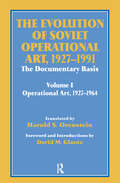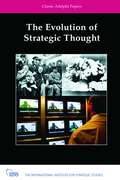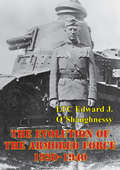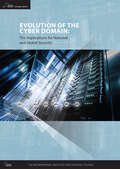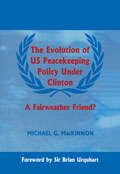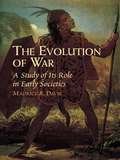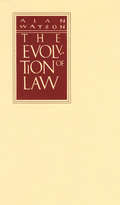- Table View
- List View
Evil For Evil: The Engineer Trilogy: Book Two (Engineer Trilogy #2)
by K. J. Parker'This is grown-up fantasy blessed with humour, intelligence and... panache. A bravura display of intricate storytelling and artfully-doled-out revelations.' - SFX'A richly textured and emotionally complex fantasy...Highly recommended.' - Library Journal (Starred Review)The engineer Ziani Vaatzes designed and built a war. Thousands died as a consequence of his elaborate plan.The civil servant Manuo Psellus took the decision that started the war. The very foundations of his world are now threatened.The ruler Duke Valens brought the war on himself. Now he must decide whether to sacrifice his country to save his people.They embarked on the war for their own reasons, but as it takes on a life of its own they find they've become components in their own machine. And the machine, it seems, has one purpose: to render evil for evil.The follow-up to Devices and Desires continues to push the boundaries of fantasy fiction in a fast-moving mix of politics, action and intelligent world-building.Books by K.J. Parker:Fencer TrilogyThe Colours in the SteelThe Belly of the BowThe Proof HouseScavenger TrilogyShadowPatternMemoryEngineer TrilogyDevices and DesiresEvil for EvilThe EscapementSaloninusBlue and GoldThe Devil You KnowTwo of SwordsThe Two of Swords: Part 1The Two of Swords: Part 2The Two of Swords: Part 3NovelsThe CompanyThe Folding KnifeThe HammerSharpsSavagesSixteen Ways to Defend a Walled CityMy Beautiful Life
Evil in the Darkness: Episode Eight
by Chris Stewart"It really grips you....I lost a lot of sleep reading it." -Tim LaHaye, co-author of the LEFT BEHIND series ONE MAN STANDS ALONE... "The battle was in motion. The same battle from long ago. The battle for the souls of men, for the soul of their country, for their own family. Eons of waiting and preparing. And now the final days were here." In the wake of a debilitating EMP attack on America, the rule of law has vanished. Amidst the chaos, the forces of Darkness use all means necessary to consolidate power into a new, illegal government formed without oversight or consent. As this clandestine group of powerful men prepares to introduce their handpicked leader to the world they learn of a major problem: The former Secretary of Defense, thought to be dead, may have somehow survived the attack. As next in the line of succession for the presidency, his presence would threaten the group's entire plan. With time running out before the public reveal of the chosen president, and the SecDef's life in grave danger, an all-or-nothing plan is hatched to infiltrate the illegal government and expose them to the world. Against the backdrop of torn-from-the-headlines Middle Eastern drama, the Wrath & Righteousness series is a fast-paced thriller that explores man's role in the eternal battle between good and evil. Chris Stewart, a world-record-setting Air Force pilot (fastest nonstop flight around the world), is the New York Times bestselling author of several books, including The Miracle of Freedom. Wrath & Righteousness is a ten episode e-book series by New York Times bestselling author Chris Stewart. Each episode is approximately 50,000-60,000 words (roughly two-thirds the length of a normal full-length novel). This series was adapted from the previously published The Great and Terrible series that was released from 2003-2008.
Evolution of Airborne Operations, 1939–1945 (Looking Down on War)
by Colonel Roy M. Stanley IIThe development of air transport in the early 20th Century led military strategists to examine the concept of inserting light infantry at key points behind enemy lines by air landing and air drop.The Germans were first off-the-mark with assaults in Norway and at Eben Emael in 1940. Crete saw a larger scale attack but while ultimately victorious the cost of men and equipment involved deterred any further Axis operation.The Allies on the other hand developed the concept dramatically with the large scale operation HUSKY in Sicily. While only partially successful there was massive loss of life and aircraft airborne operations were a key, if relatively minor, element of Op OVERLORD The D-Day Invasion.The most famous airborne operation was the large scale but ill-fated MARKET GARDEN. Almost successful the Arnhem battle goes down as a heroic defeat. The culmination of WWII airborne operations was the multi-division Rhine Crossing VARSITY.Expert author and collector Roy Stanley traces the history of airborne landings in words and pictures.
Evolution Of Artillery Tactics In General J. Lawton Collins’ US VII Corps In World War II
by Major David S. WilsonThis thesis examines the evolution of artillery tactics in World War II using General J. Lawton Collins' U.S. VII Corps as a case study. This study first reviews artillery doctrine and tactics during World War I and during the 1920s and 1930s, in which time future leaders like General Collins were military students.In 1943, General Collins commanded an infantry division on Guadalcanal where he was one of the first American generals to implement the Army's new doctrine of fire direction centers (FDCs) and massed fires using time on targets (TOTs). Collins then was selected to command the U.S. VII Corps for the invasion of Normandy and the subsequent breakout during OPERATION COBRA. From Normandy to the end of the war, Collins continued to hone his use of artillery based on his experience during the eleven-month campaign in Northwest Europe, contributing to his reputation as the best corps commander in World War II.This study looks at Army doctrine in 1944 to judge Collins' artillery tactics and concludes that he used established doctrine and that his tactics are the foundation for today's artillery tactics.
The Evolution of British Counter-Insurgency during the Cyprus Revolt, 1955–1959
by Preston Jordan LimThis book evaluates the prosecution of British counter-insurgency operations during the Cyprus Revolt of 1955-1959. Historians have typically cast the Cyprus Revolt as a failure, situating it within the larger pattern of the post-1945 failure of conventional armies to deal with insurgencies. By analyzing the reminiscences of British policemen, National Servicemen, and officers both junior and senior, the study provides a ground-up assessment of the British counter-insurgency effort. The work examines also the contradictions gripping Greek and Turkish Cypriot opinion, arguing that developments during this time period set the scene for intercommunal violence in the 1960s and 1970s. Military history is taken in a broad sense and includes the Cypriot government’s attempts to control its image in the eyes of international opinion. By intimately dealing with indigenous news outlets like the Times of Cyprus and Halkın Sesi, this book offers lessons for modern policymakers and civil servants concerned with the importance of sound press strategy.
The Evolution of Cyber War: International Norms for Emerging-Technology Weapons
by Brian M. MazanecFormer secretary of defense Leon Panetta once described cyber warfare as “the most serious threat in the twenty-first century,” capable of destroying our entire infrastructure and crippling the nation. <p><p> Already, major cyber attacks have affected countries around the world: Estonia in 2007, Georgia in 2008, Iran in 2010, and most recently the United States. As with other methods of war, cyber technology can be used not only against military forces and facilities but also against civilian targets. Information technology has enabled a new method of warfare that is proving extremely difficult to combat, let alone defeat. <p> And yet cyber warfare is still in its infancy, with innumerable possibilities and contingencies for how such conflicts may play out in the coming decades. Brian M. Mazanec examines the worldwide development of constraining norms for cyber war and predicts how those norms will unfold in the future. Employing case studies of other emerging-technology weapons—chemical and biological, strategic bombing, and nuclear weaponry—Mazanec expands previous understandings of norm-evolution theory, offering recommendations for U.S. policymakers and citizens alike as they grapple with the reality of cyber terrorism in our own backyard.
The Evolution of International Security Studies
by Barry Buzan Lene HansenProspect Theory: For Risk and Ambiguity provides the first comprehensive and accessible textbook treatment of the way decisions are made both when we have the statistical probabilities associated with uncertain future events (risk) and when we lack them (ambiguity). The book presents models, primarily prospect theory, that are both tractable and psychologically realistic. A method of presentation is chosen that makes the empirical meaning of each theoretical model completely transparent. Prospect theory has many applications in a wide variety of disciplines. The material in the book has been carefully organized to allow readers to select pathways through the book relevant to their own interests. With numerous exercises and worked examples, the book is ideally suited to the needs of students taking courses in decision theory in economics, mathematics, finance, psychology, management science, health, computer science, Bayesian statistics, and engineering.
The Evolution of International Security Studies
by Barry Buzan Lene HansenInternational Security Studies (ISS) has changed and diversified in many ways since 1945. This book provides the first intellectual history of the development of the subject in that period. It explains how ISS evolved from an initial concern with the strategic consequences of superpower rivalry and nuclear weapons, to its current diversity in which environmental, economic, human and other securities sit alongside military security, and in which approaches ranging from traditional Realist analysis to Feminism and Post-colonialism are in play. It sets out the driving forces that shaped debates in ISS, shows what makes ISS a single conversation across its diversity, and gives an authoritative account of debates on all the main topics within ISS. This is an unparalleled survey of the literature and institutions of ISS which will be an invaluable guide for all students and scholars of ISS, whether traditionalist, 'new agenda' or critical.
The Evolution Of Joint Operations During The Civil War
by LCDR Michael A. ReedHistory has demonstrated that amphibious assaults are among the most complex and challenging of all joint operations. The myriad of factors that evolved independently throughout the war did not become fully integrated until the winter of 1864-65. This thesis explores the maturation of joint amphibious operations during the U.S. Civil War, specifically through the assaults on Fort Fisher. This analysis will use modern joint doctrine as the framework to compare and contrast the two assaults. It will elaborate on how seaborne assaults differ from riverine assaults. Utilizing Fort Fisher as the focus develops an understanding of the interrelationship of these various factors and the challenges posed in their synchronization to achieve success. This study concludes that the operations reflected jointness, but also marked the emergence of modern amphibious assault concepts.
The Evolution of Military Power in the West and Asia: Security Policy in the Post-Cold War Era (Routledge Global Security Studies)
by Pauline Eadie and Wyn ReesThis book investigates how states in both the West and Asia have responded to multi-dimensional security challenges since the end of the Cold War, focusing on military transformation. Looking at a cross-section of different countries, this volume assesses how their armed forces have responded to a changing international security context. The book investigates two main themes. First, how the process of military ‘transformation’- in terms of technological advances and new ways of conducting warfare - has impacted on the militaries of various countries. These technologies are hugely expensive and the extent to which different states can afford them, and the ability of these states to utilise these technologies, differs greatly. Second, the volume investigates the social dimensions of military transformation. It reveals the expanding breadth of tasks that contemporary armed forces have been required to address. This includes the need for military forces to work with other actors, such as non-governmental agencies and humanitarian organisations, and the ability of armed forces to fight asymmetric opponents and conduct post-conflict reconstruction tasks. The conflicts in Iraq and Afghanistan exemplified how important the relationship between technological and social transformation has become. This book will be of much interest to students of strategic studies, military innovation, Asian politics, security studies and International Relations.
The Evolution of Modern Land Warfare: Theory and Practice (Routledge Library Editions: Military and Naval History)
by Christopher BellamyExtensively illustrated with 52 detailed campaign and battle maps and diagrams, this book, originally published in 1990, surveys the evolution of warfare in Europe from Napoleon to the end of the twentieth century and in Asia from the Middle Ages. It considers the interaction of technology and warfare. With wide-ranging examples, the book includes two in depth case studies, one on the Soviet Operational Manoeuvre Group and its predecessors in the Russian Imperial Army, the other on the history of land warfare, including guerilla warfare, in Asia. In this book the author demonstrates that military history can be of immense practical help to the modern military analyst and professional. Now updated with a new introduction to take into account changes since 1990, this book remains of essential value to students, teachers & professionals in political & social history, international relations, defence, war & peace studies.
The Evolution of Operational Art, 1740-1813: From Frederick the Great to Napoleon (Military History and Policy)
by Claus TelpOperational art emerged from the campaigns of Frederick the Great to the end of the Napoleonic Wars. It was the result of three dynamic interrelationships: between military and non-military factors such as social, economic and political developments; between military theory and practice; and between developments in military theory and practice in France and Prussia.In the period 1740-1815 a major change in the complexity of warfare took place. This was reflected by an increase in the complexity of the analysis of warfare via the introduction of the operational level between the strategic and tactical levels.The evolution of operational art, driven by these three dialectical processes, evolved in stages. In the first stage, Revolutionary France had experimented with operational art though with limited success. Then, Napoleon had used it with remarkable success against an adversary clinging to outdated modes of warfare and organisation. In the final stage, Napoleon's operational art was successfully challenged by the Prussian brand.
The Evolution of Soviet Operational Art, 1927-1991: The Documentary Basis: Volume 2 (1965-1991) (Soviet (Russian) Study of War #No. 6-7)
by David M. Glantz Harold S. OrensteinThe Soviet military concept of operational art and the associated theories such as "war of annihilations", "deep battle", and "deep operations" have been observed by the West since World War II. The Soviet government hid their military-theoretical work behind a veil of secrecy. Here, the Soviet theories are revealed in the words of those who created them in peacetime and applied them in war.
The Evolution of Soviet Operational Art, 1927-1991: The Documentary Basis: Volume 1 (Operational Art 1927-1964) (Soviet (Russian) Study of War #No. 6-7)
by Harold S. Orenstein David M. GlantzThis collection of texts has been taken from formerly classified material in the official Red Army General Staff journal 'Military Thought'. The results are two volumes of great scope based on archival evidence. They stand as a compulsory reference point for anyone with an interest in the operational endeavours of the Soviet Army from the 1920's onward.
The Evolution of Strategic Thought: Classic Adelphi Papers
by Classic Adelphi PapersThe Adelphi Papers monograph series is the International Institute for Strategic Studies' principal contribution to policy-relevant, original academic research. Collected on the occasion of the Institute's 50th anniversary, the twelve Adelphi Papers in this volume represent some of the finest examples of writing on strategic issues. They offer
The Evolution of Strategy
by Beatrice HeuserIs there a 'Western way of war' which pursues battles of annihilation and single-minded military victory? Is warfare on a path to ever greater destructive force? This magisterial new account answers these questions by tracing the history of Western thinking about strategy - the employment of military force as a political instrument - from antiquity to the present day. Assessing sources from Vegetius to contemporary America, and with a particular focus on strategy since the Napoleonic Wars, Beatrice Heuser explores the evolution of strategic thought, the social institutions, norms and patterns of behaviour within which it operates, the policies that guide it and the cultures that influence it. Ranging across technology and warfare, total warfare and small wars as well as land, sea, air and nuclear warfare, she demonstrates that warfare and strategic thinking have fluctuated wildly in their aims, intensity, limitations and excesses over the past two millennia.
The Evolution Of The Armored Force, 1920-1940
by Ltc Edward J. O’shaughnessy Jr.In armored force circles the inter-war years are sometimes referred to as the "lean years." The abolishment of the separate Tank Corps in 1920, the Depression Era budget constraints and a lack of national strategic vision have caused a mistaken belief that little attention was paid to the development of armored force structure and doctrine in this critical time period. In fact the evidence points to the contrary. Rather than development by a kick start in 1940, the evidence illustrates an evolution of armored doctrine and force structure. The process started immediately upon return from World War I by a core of tank visionaries and advocates. The fruits of their labors were realized in 1940 when war demanded the rapid fielding of armored divisions. The fact that fourteen divisions were fielded in four years, when none had existed previously, is testimony to their efforts. This paper is told from their perspective. In the face of significant institutional obstacles these tank advocates responded to a higher calling. The inter-war period has parallels for us today. Once again we have declared victory, are downsizing our force structure and slashing our defense budget. Will we retain and encourage within our ranks visionaries and advocates to prepare our military for future conflict as we enter a new "lean years" era?
Evolution of the Cyber Domain: The Implications for National and Global Security
by The International Institute for Strategic StudiesCyber security has become a focal point for conflicting domestic and international interests, and increasingly for the projection of state power. The military utility of the cyber domain is linked to the economic and social potential of information and communications technologies (ICTs), while technologies with military and national-security applications have become essential to the conduct of modern life.In light of this, Evolution of the Cyber Domain provides a holistic review of the strategic, operational and technical issues at the centre of the international cyber-security debate. The Dossier charts and contextualises the key developments and trends that have shaped the cyber domain since the 1950s. As well as tracking the events and decisions underlying the military potential of ICTs, it examines the issues and policies that affect global governance of the internet.The Dossier analyses:• The geopolitics of international cyber security and technological development.• The challenges of creating methods for managing conflict within the cyber domain based on international law.• The tension between issues of privacy, freedom of information and national security.• Intelligence as a state practice in peace and war.• The development and use of cyber military capabilities.The Dossier is an important point of reference for further research and analysis on complex cyber-security issues, and it provides a series of insights into national positions, as well as regional and global agreements and policies. Evolution of the Cyber Domain is a useful resource for readers who seek a comprehensive picture of cyber affairs, and who wish to understand the social, economic and politico-military challenges that have guided the development and use of ICTs in the past six decades. By summarising the ways in which governments are addressing these challenges at the strategic level, it helps prepare decision-makers and researchers involved in the formulation of cyber-security policy, strategy and analysis. The Dossier also contains a glossary of the key terms and concepts in the cyber-security dialogue.
The Evolution of the US Air Force: Organizational Culture and Preparedness for War (Cass Military Studies)
by Israel GuyThis book looks at the history of the US Air Force through the lens of its (lack of) preparedness for major wars, which is shown to be a result of its organizational culture.The U.S. Air Force is probably the most powerful military force in history, both in its destructive firepower and in its ability to project it globally. Yet, despite its unparalleled power, the Air Force entered its first three pivotal conflicts – World War II, the Korean War, and the Vietnam War – unprepared. But surprisingly, it was remarkably well prepared for its fourth major war: the Gulf War of 1991. Could there be an underlying trait or characteristic, which influenced the Air Force between the wars, that historically caused the US Air Force to be unprepared for war or prepared for the wrong type of war? Surprisingly, there is such a factor which was quite prominent in the Air Force’s complex identity – its organizational culture. Besides providing a historical description of the Air Force, this book demonstrates clearly how its organizational culture evolved and how it caused the US Air Force to be prepared for the wrong war. It also shows that when the organizational culture changed, the Air Force changed its focus and arrived prepared for the following war: the 1991 Gulf War.This book will be of interest to students of air power, strategic studies, US public policy, and security studies in general.
The Evolution of U.S. Military Policy from the Constitution to the Present, Volume I: The Old Regime: The Army, Militia, and Volunteers from Colonial Times to the Spanish-American War (G - Reference,information And Interdisciplinary Subjects Ser.)
by Gian Gentile Jameson Karns Michael Shurkin Adam GivensTracing the evolution of the U.S. Army throughout American history, the authors of this four-volume series show that there is no such thing as a “traditional” U.S. military policy. Rather, the laws that authorize, empower, and govern the U.S. armed forces emerged from long-standing debates and a series of legislative compromises between 1903 and 1940. Volume I traces U.S. military policy from the colonial era through the Spanish-American War.
The Evolution of U.S. Military Policy from the Constitution to the Present, Volume II: The Formative Years for U.S. Military Policy, 1898-1940 (G - Reference,information And Interdisciplinary Subjects Ser.)
by Sean M. Zeigler Alexandra Evans Gian Gentile Badreddine AhtchiTracing the evolution of the U.S. Army throughout American history, the authors of this four-volume series show that there is no such thing as a “traditional” U.S. military policy. Rather, the laws that authorize, empower, and govern the U.S. armed forces emerged from long-standing debates and a series of legislative compromises between 1903 and 1940. Volume II focuses on the laws enacted in the early 20th century that transformed the Army.
The Evolution of U.S. Military Policy from the Constitution to the Present, Volume IV: The Total Force Policy Era, 1970–2015 (G - Reference,information And Interdisciplinary Subjects Ser.)
by M Wade Markel Alexandra Evans Miranda Priebe Adam Givens Jameson Karns Gian GentileTracing the evolution of the U.S. Army throughout American history, the authors of this four-volume series show that there is no such thing as a “traditional” U.S. military policy. Rather, the laws that authorize, empower, and govern the U.S. armed forces emerged from long-standing debates and a series of legislative compromises between 1903 and 1940. Volume IV traces how Total Force Policy has been implemented since 1970.
The Evolution of US Peacekeeping Policy Under Clinton: A Fairweather Friend?
by Michael G. MacKinnonThis fascinating study examines the dynamic process through which the Clinton administration developed a policy towards UN peace support operations. The author addresses the fundamental question: what factors influenced the shift in US policy towards the United Nations and its peace support operations and which factors were clearly dominant?Based on primary sources and interviews with political personalities and officials, the author examines four main factors which shaped the development of policy: the Executive branch, the bureaucracies (the State Department and Department of Defense), Congress and public opinion. These provide the basis for the core chapters of the book, which also contains a chapter on methodology and a chapter of summary analysis.
The Evolution of War: A Study of Its Role in Early Societies
by Maurice R. DavieThorough, highly informative and exhaustive study presents an exceptional collection of cases examining such topics as warfare as the business of one sex, religion as a cause of war, and war for the sake of glory. Cannibalism, human sacrifice, blood-revenge, and other factors in warfare among primitive peoples are also expertly examined.
The Evolution of Western Private Law
by Alan WatsonIn The Evolution of Western Private Law, renowned legal scholar Alan Watson presents a comprehensive overview of legal change in the Western world. Watson explains why and how such change occurs in mature systems, in underdeveloped systems, and when legal systems of different levels of sophistication and from different societal roots—such as those of the Romans and of Germanic tribes—come into contact.Originally intended as a second edition of the author's widely acclaimed The Evolution of Law (1985), this expanded edition has been completely restructured with more than double the number of examples. The result is a work that incorporates all the ideas that Watson has put forward during his twenty-five years studying comparative law and the development of legal systems, combining a remarkable range of sources with superb insight.
